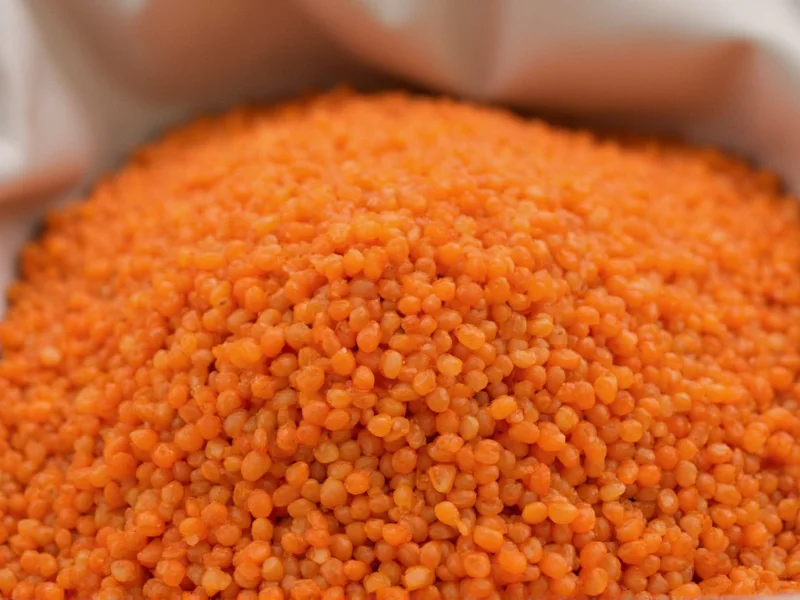What Makes Red Lentils Unique Among Legumes
Red lentils, scientifically known as Lens culinaris, stand out in the legume family for their distinctive characteristics. Unlike green or brown lentils that maintain their shape when cooked, red varieties break down easily, creating a smooth, porridge-like consistency perfect for thickening dishes. This quality makes them indispensable in Indian dals and Middle Eastern mujadara.
Nutritional Powerhouse: Health Benefits Backed by Science
One cup of cooked red lentils delivers remarkable nutritional value that supports multiple aspects of health. Their high soluble fiber content helps regulate cholesterol and blood sugar levels, while the significant folate concentration supports cardiovascular health. The iron content (6.6mg per cup) makes them valuable for preventing anemia, especially when paired with vitamin C-rich foods to enhance absorption.
| Nutrient | Per Cooked Cup (198g) | % Daily Value |
|---|---|---|
| Calories | 230 | 12% |
| Protein | 18g | 36% |
| Fiber | 15g | 54% |
| Folate | 358mcg | 90% |
| Iron | 6.6mg | 37% |
Red Lentils vs Other Varieties: Key Differences
Understanding red lentils versus brown lentils helps home cooks choose the right variety for their recipes. While brown lentils maintain their shape after 20-30 minutes of cooking, red lentils dissolve completely in 15-20 minutes. Black lentils (beluga) hold their shape even longer and offer earthier flavor, while French green lentils (Puy) remain firm after extended cooking. Red lentils' quick cooking time and soft texture make them ideal for purees, baby food, and thickening soups without additional starches.
Mastering Red Lentil Preparation: Step-by-Step Guide
Proper preparation ensures perfect results every time you're cooking red lentils. Start by spreading lentils on a light-colored plate to spot any small stones. Rinse thoroughly in a fine-mesh strainer under cold water until the water runs clear. For basic preparation, use a 2:1 water-to-lentil ratio. Bring to a boil, then reduce heat and simmer uncovered for 15-20 minutes until tender. Unlike other legumes, red lentils don't require soaking, but rinsing removes surface starch that can cause foaming.
Avoiding Common Cooking Mistakes
Acidic ingredients like tomatoes or vinegar added too early can prevent lentils from softening properly. Wait until lentils are nearly cooked before adding acidic components. Overcooking isn't typically an issue with red lentils since they're meant to break down, but undercooking leaves them unpleasantly gritty. For soups and stews, add red lentils midway through cooking to achieve perfect texture.
Top Red Lentil Recipes for Every Meal
Discover why red lentils are perfect for quick weeknight meals. Their fast cooking time makes them ideal for busy schedules. Classic Indian red lentil dal combines lentils with turmeric, cumin, and garlic for a nourishing dish ready in under 30 minutes. For Western palates, try adding them to tomato soup for natural thickening and protein boost. Red lentil curry with coconut milk creates a creamy, dairy-free sauce that pairs beautifully with rice. They also work surprisingly well in baked goods—try substituting 1/4 cup cooked lentils for fat in brownie recipes for added nutrition.
Storage Guidelines for Maximum Freshness
Proper storage extends the shelf life of both dried and cooked red lentils. Keep dried lentils in airtight containers in a cool, dark place where they'll maintain quality for 1-2 years. For cooked lentils, cool completely before transferring to refrigerator containers. They'll stay fresh for 5-7 days refrigerated or up to 6 months frozen. When freezing, portion into 1-2 cup servings in freezer bags with as much air removed as possible. Thaw overnight in the refrigerator before using in soups, salads, or as a quick side dish.
Frequently Asked Questions About Red Lentils
Do red lentils need to be soaked before cooking?
No, red lentils don't require soaking. Unlike beans or some other lentil varieties, they cook quickly in 15-20 minutes without pre-soaking. Simply rinse them thoroughly to remove any dust or debris before cooking. This makes them one of the most convenient legumes for quick meals.
How do red lentils compare nutritionally to other lentil types?
Red lentils have similar protein content to other varieties (about 18g per cooked cup) but slightly less fiber than green or black lentils. Their standout nutritional feature is higher folate content, providing 90% of the daily value per serving. They also contain significant iron and potassium, though the iron is non-heme (plant-based) and benefits from being consumed with vitamin C for better absorption.
Can I substitute red lentils for other lentils in recipes?
Substitution depends on the recipe's texture requirements. Red lentils work well in soups, stews, and purees where a soft texture is desired. They're not suitable for salads or dishes requiring distinct lentil shapes. When substituting for brown lentils, reduce cooking time significantly as red lentils cook much faster. For recipes specifically calling for whole lentils that maintain shape, consider using French green lentils instead.
Why do my red lentils turn mushy when cooking?
Red lentils are naturally meant to break down when cooked, which is why they're perfect for dals and thick soups. If you're getting unexpectedly mushy results, you might be overcooking them or using too much water. Try reducing cooking time to 12-15 minutes and using a 1.5:1 water-to-lentil ratio for a slightly firmer texture while still maintaining their characteristic softness.
Are red lentils good for weight loss?
Yes, red lentils support weight management through multiple mechanisms. Their high protein and fiber content promotes satiety, helping you feel full longer. With 230 calories per cooked cup and minimal fat, they provide substantial nutrition without excess calories. The complex carbohydrates offer sustained energy release, preventing blood sugar spikes that lead to cravings. Incorporating red lentils into meals can help reduce overall calorie intake while maintaining nutritional adequacy.











 浙公网安备
33010002000092号
浙公网安备
33010002000092号 浙B2-20120091-4
浙B2-20120091-4